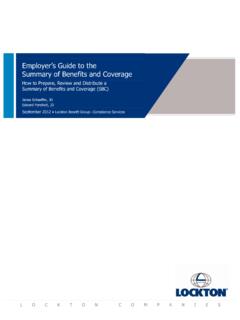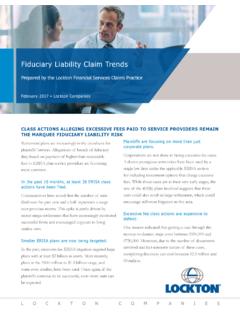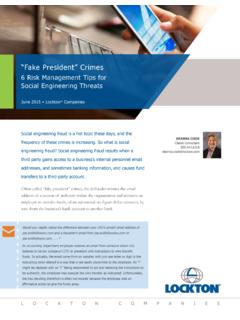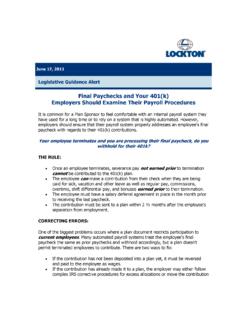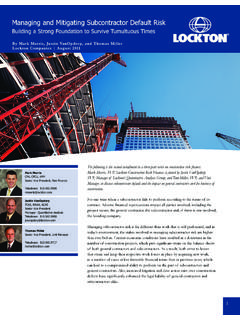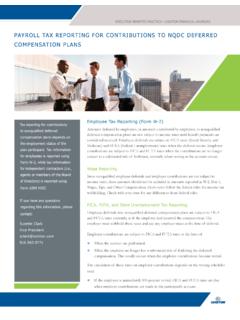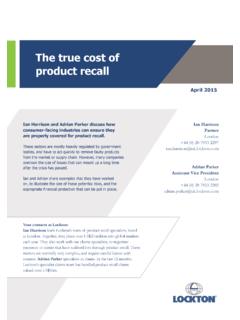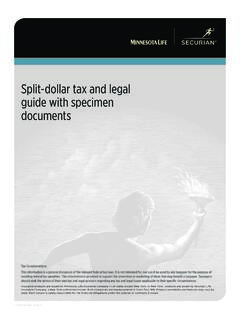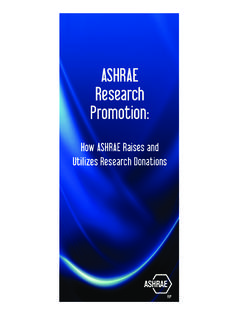Transcription of Nonsubscription in Texas - Lockton Companies
1 Nonsubscription in TexasA True Alternative to Workers CompensationAugust 2014 Lockton CompaniesOriginally published December 2010 Lockton COMPANIESSTEVE DEVORES enior Vice PresidentUnit managers identify and manage potential risks, and take the appropriate steps to either eliminate or mitigate the threat of damage and associated loss costs. Risk managers contribute to the success of their organizations by measuring risk and comparing risk with possible rewards. Understanding the potential rewards of implementing a Texas Nonsubscription program is one opportunity that can reduce an organization s overall cost of NonsubscriptionTexas is a state that allows an option to not purchase workers compensation coverage, regardless of the number of employees, company size, or type of business.
2 Workers compensation is still elective in Texas today. As of 2014, Oklahoma allows a similar option, although in that state the benefit levels are different, and unlike Texas the exclusive remedy defense is retained by the is the only alternative to the Texas workers compensation system. Nonsubscription employers are not the same as a certified self-insured employers. Self-insured employers must abide by the requirements of the Texas workers compensation rules and learn more about the Oklahoma system, is estimated that approximately one-third of all Texas employers are nonsubscribers. The Texas Labor Code prohibits public entities, maritime and FELA employers, and businesses who participate in government construction projects from being nonsubscribers. Nonsubscribers, however, can be found in almost every other segment of our business choose Nonsubscription for a variety of reasons: High cost of workers compensation insurance premiums.
3 Escalating medical costs; workers compensation lifetime medical benefits. More effective medical and disability management of employee injury claims. Significantly increased claim closure and liquidation rates. Required 24-hour or end-of-shift reporting. No collateral requirements. Typical savings of 40-70 percent over workers compensation overall majority of savings under Nonsubscription will come from the fact that employers will have greater control over most aspects of the injury process. The ability of employers to direct employees to medical providers that understand Nonsubscription reduces the extent of lost time from work, yet provides the employee with the appropriate care and quality medical LiabilityNonsubscription, however, does have some unique legal characteristics when compared to workers compensation.
4 Nonsubscribing employers lose their right to the exclusive remedy doctrine. Exclusive remedy provisions of the workers compensation statute protect the employer from common law suits by employees to recover for work-related injuries. Having workers compensation does not always protect an employer from legal liability in the event of all accidents including an employee s death. In such an event, the workers compensation subscriber, like the nonsubscriber, can be subject to a variety of alleged damages resulting from lawsuits associated with a death claim: loss of consortium, past and future lost wages, loss of support, and potentially, punitive damages. The liability investigation is a critical and additional component that must be completed when handling a nonsubscriber claim investigation.
5 Under the analysis of whether employer s negligence has occurred, Texas courts recognize an employer owes the following duties: To provide employees with a reasonably safe place to work. To ensure the safety of all employees and establish rules for their safety. To select careful and competent fellow workers. To furnish an employee with safe and suitable appliances or tools; to do the work with reasonable 2014 Lockton Companies3An employer has a duty to establish and enforce rules and regulations for the safety of its employees. A plaintiff employee must prove that the employer s negligent acts proximately caused the injury. Proximate cause includes two essential elements: (1) cause in fact and (2) foreseeability. Negligence means the failure to use ordinary care: failing to do what an ordinary, prudent person would have done under the same or similar circumstances.
6 Proximate cause means that cause which, in a natural and continuous sequence, produces an event, and without cause such event would not have occurred. In order to be a proximate cause, the act or omission complained of must be such that a person using ordinary care would have foreseen that the event, or some similar event, might reasonably result therefrom. There may be more than one proximate cause of an event. To help prevent potential legal liability exposure, a commitment to workplace safety by the employers corporate and local management team is critical to a nonsubscriber s success. A highly effective (and documented) safety program will be required with respect to all Texas operations for the purpose of not only preventing employee injuries in general, but also to serve as the basis of a legal defense in those situations in which an employee brings a civil action or files for arbitration.
7 Employers must commit to training and Benefit PlansMost Nonsubscription employers provide their employees with an Occupational Injury Benefits Plan with the purpose of providing their employees with similar work-related benefits in the event of an injury medical and income replacement benefits. The Occupational Injury Benefit plan is a document that specifies the benefits that will be provided to employees under the plan in the event of injury, including any restrictions, conditions, or requirements. An Occupational Injury Benefit Plan should be constructed and filed as an ERISA plan, similar to employee Group Benefit and related plans. The ERISA status provides the employer with significant legal protections. Constructed to comply with the Employee Retirement Income Security Act of 1974 (ERISA): legal counsel would be more competent to explain.
8 Qualify the plan for fiduciary coverage as an ERISA plan. Employees can be required to sign a binding arbitration agreement in exchange for the provision of voluntary benefits under the plan. This is effective at least 90-95 percent of the time and prevents an injured employee from filing suit and seeking remedies through the civil court help prevent potential legal liability exposure, a commitment to workplace safety by the employers corporate and local management team is critical to a nonsubscriber s An employee does not have to accept the plan agreement. They can maintain their right to pursue claims in the Civil Court system if they are injured: assuming they can prove that their injury was a result of employer s negligence. Most employers who roll out a Nonsubscription program experience employee plan acceptance rates ranging from 80-95 percent.
9 Most ERISA Plans designed for occupational injury benefits are 80-90 percent boilerplate with many similar and standard provisions. The structure and benefits provided by the plan are created at the discretion of the employer, subject to compliance with the relevant ERISA requirements. There will be an impact on the employer from an employer tax/contributions perspective, since wage loss benefits under Nonsubscription plans are considered taxable income for both the employee and the following table is an example of plan benefit design:Benefits ProvidedUnder Texas WCUnder Benefit PlanWaiting Period7 Days0-3 DaysWage Loss Benefits70% if pay is more than $ if pay is less than $ Weekly Wage Loss Benefit Up to $850 per week until Maximum MedicalImprovement or 104 , Impairment and Supplement benefits could total up to 401 weeks$750up to maximum 110-120 weeksMedical BenefitLifetime100% of covered charges for up to 110-120 weeksMaximum Plan LimitsStatutory$150,000 per personAugust 2014 Lockton Companies5It is our recommendation that you engage a consultant or legal counsel to prepare the ERISA Plan document.
10 This firm should also be utilized to file all required state and federal documents associated with adopting an Occupational Injury Benefit Plan under ERISA. The cost of hiring such a firm to aid in the review and structuring of the ERISA plan and implementation of a nonsubscriber program will vary by employer, based on claim volume and complexity of your program. Lockton can assist in providing names of firms to assist in this InsuranceIt is important that your insurance program under Nonsubscription is structured in the most economical manner. Texas Employers Excess Indemnity or Employer Legal Liability insurance policies, which provide excess loss coverage on a per occurrence or per claim basis, above the self-insured retention, must be compatible with the benefit plan so that there are no insurance coverage gaps.
